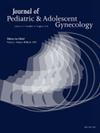38. 青春期女性压力与月经周期异常关系的探讨
IF 1.7
4区 医学
Q3 OBSTETRICS & GYNECOLOGY
引用次数: 0
摘要
月经模式异常通常是由于下丘脑-垂体-卵巢(HPO)轴的失调或不成熟,这是一个受压力和皮质醇水平升高影响的生物学过程。先前在印度进行的研究表明,青少年压力升高与月经异常之间存在联系。我们的研究探讨了美国青春期女孩的心理压力和月经周期不规律之间的关系,以建立基线数据,为改善女性青少年健康的策略提供信息。该机构的内部审查委员会批准了我们的研究。我们向我们的大型大学儿科妇科门诊的新患者分发了一份匿名调查。符合条件的患者为未满21岁的未怀孕、说英语或西班牙语的个体,未接受激素治疗,无化疗、放疗、子宫发育不全或原发性卵巢功能不全史。在适当情况下获得法定监护人的同意和参与者的同意。参与者完成了调查,其中包括感知压力量表(PSS),关于月经周期的问卷调查,以及基本的人口统计信息。数据分析包括描述性统计。分类变量分析采用卡方检验,p值为<;0.05认为有统计学意义。结果100名受试者中,64名符合月经异常标准,月经周期≥1天/月,周期≥7天/月。4天,或者流量大,每天需要更换5次以上饱和的卫生巾/卫生棉条。大多数人口(84%)是西班牙裔。大多数参与者报告了中等(62)到高(27)的压力水平。尽管压力的发生率很高,但它并不是月经异常的预测因子(p=0.71)。分别有29名和18名参与者报告了焦虑和抑郁。这些合并症也不能预测压力。尽管如此,74名参与者报告说,在月经周期中,她们的情绪变化相当或非常频繁。结论在我国少数民族人群中,月经不调和应激水平升高的发生率显著。然而,在本研究中,没有发现这两个变量之间有统计学意义的关联。压力对HPO轴的影响,因此对月经的影响,可能没有以前认为的那么强烈,但这两个变量的频率表明需要进行更大规模的研究。我们的发现强调了进一步研究青春期压力的必要性,以降低年轻女孩的压力水平,并更好地了解影响月经异常的因素。本文章由计算机程序翻译,如有差异,请以英文原文为准。
38. Exploring the Relationship Between Stress and Menstrual Cycle Abnormalities in Adolescent Females
Background
Abnormal menstrual patterns often result from dysregulation or immaturity of the hypothalamic-pituitary-ovarian (HPO) axis, a biological process influenced by stress and elevated cortisol levels. Prior work done in India demonstrated a link between elevated stress in teenagers and abnormal menses. Our study explores the relationship between psychological stress and irregular menstrual cycles in adolescent girls in the United States to establish baseline data to inform strategies for improving female teenage health.
Methods
The institution's IRB approved our study. We distributed an anonymous survey to new patients at our large university outpatient pediatric gynecology clinic. Eligible patients were non-pregnant, English or Spanish-speaking individuals under 21 years old, not on hormonal therapies, with no history of chemotherapy, radiation, uterine agenesis, or primary ovarian insufficiency. Consent from legal guardians and assent from participants was obtained as appropriate. Participants completed the survey, which included the Perceived Stress Scale (PSS), a questionnaire about their menstrual cycles, and basic demographic information. Data analysis included descriptive statistics. Categorical variables were analyzed using chi-square tests, with a p-value of < 0.05 considered statistically significant.
Results
Of 100 participants, 64 met the criteria for abnormal menses, indicated by a frequency of menses more or less frequently than 1/month, a cycle lasting >7 days or < 4 days, or a heavy flow requiring 5+ changes of saturated sanitary pads/tampons daily. The majority (84%) of the population was Hispanic. Most participants reported moderate (62) to high (27) stress levels. Despite the high incidence of stress, it was not found to be a predictor of abnormal menses (p=0.71). Anxiety and depression were reported by 29 and 18 participants, respectively. These comorbidities were not predictive of stress either. Still, 74 participants reported experiencing mood changes either fairly or very often during their menstrual cycle.
Conclusions
The incidence of both irregular menses and elevated stress levels in our minority-majority population is notable. However, in this study, no statistically significant association was found between the two variables. Stress's impact on the HPO axis, and therefore menses, may not be as strong as previously thought, but the frequency of both variables indicates the need for a larger study. Our findings highlight the need for further research into adolescent stress to reduce these heightened levels in young girls and to better understand factors influencing menstrual abnormalities.
求助全文
通过发布文献求助,成功后即可免费获取论文全文。
去求助
来源期刊
CiteScore
3.90
自引率
11.10%
发文量
251
审稿时长
57 days
期刊介绍:
Journal of Pediatric and Adolescent Gynecology includes all aspects of clinical and basic science research in pediatric and adolescent gynecology. The Journal draws on expertise from a variety of disciplines including pediatrics, obstetrics and gynecology, reproduction and gynecology, reproductive and pediatric endocrinology, genetics, and molecular biology.
The Journal of Pediatric and Adolescent Gynecology features original studies, review articles, book and literature reviews, letters to the editor, and communications in brief. It is an essential resource for the libraries of OB/GYN specialists, as well as pediatricians and primary care physicians.

 求助内容:
求助内容: 应助结果提醒方式:
应助结果提醒方式:


